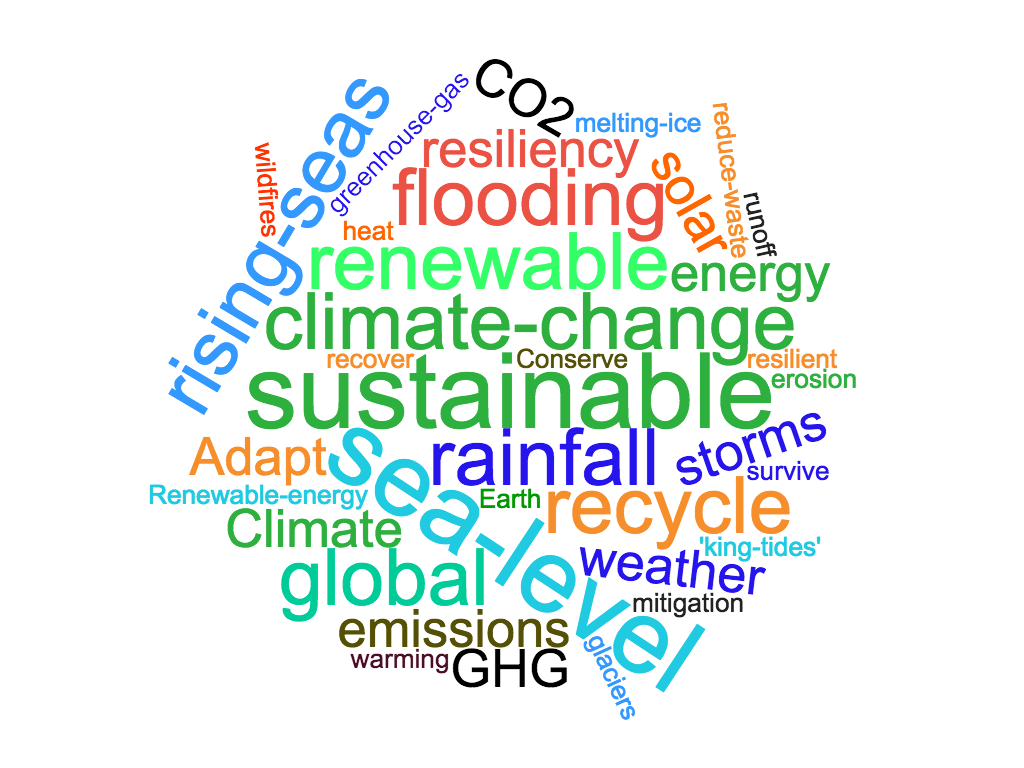Which Kind of Sustainable Do You Mean?

[Graphic may be used per Creative Commons. See www.johnenglander.net/wordclouds for other versions.]
When a term means very different things it can actually become a barrier to good communication. Clarity is needed if we are going to set goals that can really solve problems, particularly the really big problems.
What are the different meanings of sustainability? I identify at least five aspects:
- Sustainable materials use, such as recycled items, or fast growing forest products
- Programs to reduce waste in various forms
- Sustainable energy, i.e. renewable energy
- Reduction of greenhouse gases to slow climate change, such as energy efficient buildings
- Sustainable operation during disasters, like flooding, often described as resiliency
In a pure sense, sustainable conveys something that will last and be durable. The problem starts with the term of reference. Do we mean a) the building lasting for a longer time, even under more adverse conditions, or b) do we mean that certain practices will allow us to have a heathy environment, looking to the wider human population, now more than seven plus billion. The microcosm (us) or the macrocosm (the planet).They may seem similar, but are of course entirely different.
To make the issue clear, let’s imagine an architect who is told to “design a sustainable building”, almost as an added instruction on a project where the owner assumes the term is self-evident. Or perhaps the owner is not sure what sustainable means, but likes the concept, and trusts the architect to know what it means. This might apply to a home, a large commercial building, or even a new community. With that instruction, the architect might:
- Use recycled materials to reduce demand for virgin materials.
- Make the building energy efficient with thick walls and insulated glass, to reduce global energy demand, and the “greenhouse gas emissions” associated with fossil fuel power generation,
- Specify its own solar and wind energy, to be “off the grid”, possibly with its own generator to sustain operations during interruptions of power supply.
- Consider water supply and wastewater in terms of sustainability, which raises several possibilities from an onsite well, to onsite treatment of wastewater, depending on the location (urban or rural), zoning and other regulations.
- Design and build so that it is resistant to flooding, perhaps elevating on stilts to reduce routine flooding and be prepared for future sea level. Or perhaps design a building that can float.
- Design to minimize for wind damage from hurricanes or tornadoes, perhaps with massive concrete and steel anchored firmly in the ground.
- Advocate for a smaller structure to minimize materials used, energy, heating and air conditioning. etc.
- Add a large vegetable garden to be more self sustainable for food supply; in the right setting, perhaps even adding a facility to produce animal protein like shrimp aquaculture.
- Feature the proximity or connection to public transport to minimize the need to drive, reducing GHG from automobiles.
In some situations, might the architect advise the owner to sell that parcel and find one where the desired sustainability can be better achieved?
As you can see from the above list, there are many different aspects and implementations, all of which could be covered by “sustainability.” One specific case of confusion is worth noting:
Improving energy efficiency and the use of renewable sources is extremely important to reduce carbon dioxide emissions (CO2), one of the primary greenhouse gases (GHG) that correlate the warming temperature and other effects (including raising sea level). (#2 above) Those emissions blend in the atmosphere and have a cumulative global effect. It takes collective global effort over many years to make a significant change in CO2 level.
Preparing for rising sea level and the increased flooding from extraordinary rain, storms, and high tides is a completely local issue, which varies by location. (#5 above)
Both of these items can be seen as aspects of sustainability but are quite different in terms of design solutions. Even if a building (or city) had zero emissions, that would have zero effect on its flood vulnerability.
Sustainability is an important and useful concept. It just needs to be given context or clarity if we are going to communicate well.
It should also remind us of other terms such as environmentally friendly, “green”, resilient, and renewable, that each have somewhat different meanings. We need to use them carefully and appropriately to communicate clearly to address the problems that we must solve.
